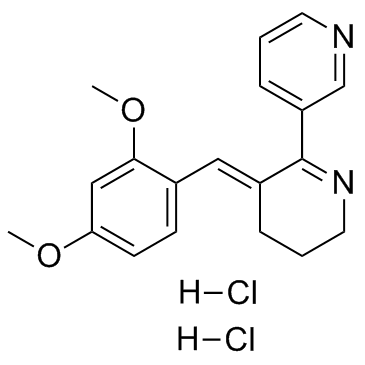GTS-21

GTS-21 structure
|
Common Name | GTS-21 | ||
|---|---|---|---|---|
| CAS Number | 156223-05-1 | Molecular Weight | 381.30 | |
| Density | 1.1±0.1 g/cm3 | Boiling Point | 485.6±45.0 °C at 760 mmHg | |
| Molecular Formula | C19H22Cl2N2O2 | Melting Point | 216-217℃ (decomposition) | |
| MSDS | USA | Flash Point | 247.5±28.7 °C | |
Use of GTS-21GTS-21 dihydrochloride is a selective α7 nicotinic acetylcholine receptor agonist, has recently been established as a promising treatment for inflammation. Target: nAChRin vitro: GTS-21 is one of the most potent α7nAChR agonists, has been reported to attenuate pro-inflammatory cytokine production, improve outcomes in sepsis models, pancreatitis, and ischemia-reperfusion injury, and inhibit the production of endotoxin-induced TNF in lung tissue. In addition, recent studies have demonstrated that GTS-21 inhibits the activities of endothelial cells and monocyte macrophages, as well as the secretion of pro-inflammatory cytokines in peripheral blood samples, by regulating the JAK2-STAT3 pathway. [1] in vivo: In septic animals, GTS-21 significantly ameliorated GI motility, lowered systemic and colonic levels of IL-6, decreased colonic permeability, and decreased the number of positive cultures obtained from blood and mesenteric lymph nodes. Splenectomy prevented animals from developing sepsis-induced ileus. Chrna7 mice displayed a more severe septic phenotype, whereas GTS-21 remarkably was also beneficial in these animals. [2] |
| Name | 3-(2,4-Dimethoxy-benzyl)-3,4,5,6-tetrahydro-[2,3']bipyridinyl |
|---|---|
| Synonym | More Synonyms |
| Description | GTS-21 dihydrochloride is a selective α7 nicotinic acetylcholine receptor agonist, has recently been established as a promising treatment for inflammation. Target: nAChRin vitro: GTS-21 is one of the most potent α7nAChR agonists, has been reported to attenuate pro-inflammatory cytokine production, improve outcomes in sepsis models, pancreatitis, and ischemia-reperfusion injury, and inhibit the production of endotoxin-induced TNF in lung tissue. In addition, recent studies have demonstrated that GTS-21 inhibits the activities of endothelial cells and monocyte macrophages, as well as the secretion of pro-inflammatory cytokines in peripheral blood samples, by regulating the JAK2-STAT3 pathway. [1] in vivo: In septic animals, GTS-21 significantly ameliorated GI motility, lowered systemic and colonic levels of IL-6, decreased colonic permeability, and decreased the number of positive cultures obtained from blood and mesenteric lymph nodes. Splenectomy prevented animals from developing sepsis-induced ileus. Chrna7 mice displayed a more severe septic phenotype, whereas GTS-21 remarkably was also beneficial in these animals. [2] |
|---|---|
| Related Catalog | |
| References |
| Density | 1.1±0.1 g/cm3 |
|---|---|
| Boiling Point | 485.6±45.0 °C at 760 mmHg |
| Melting Point | 216-217℃ (decomposition) |
| Molecular Formula | C19H22Cl2N2O2 |
| Molecular Weight | 381.30 |
| Flash Point | 247.5±28.7 °C |
| PSA | 43.71000 |
| LogP | 2.64 |
| Appearance of Characters | powder,faint yellow to dark yellow |
| Vapour Pressure | 0.0±1.2 mmHg at 25°C |
| Index of Refraction | 1.580 |
| InChIKey | BXKYFUGAAFLYJL-UHFFFAOYSA-N |
| SMILES | COc1ccc(C=C2CCCN=C2c2cccnc2)c(OC)c1.Cl.Cl |
| Storage condition | 2-8°C |
| Water Solubility | H2O: >5mg/mL |
| RIDADR | NONH for all modes of transport |
|---|---|
| WGK Germany | 3 |
| RTECS | DW1764860 |
| HS Code | 2933399090 |
| HS Code | 2933399090 |
|---|---|
| Summary | 2933399090. other compounds containing an unfused pyridine ring (whether or not hydrogenated) in the structure. VAT:17.0%. Tax rebate rate:13.0%. . MFN tariff:6.5%. General tariff:20.0% |
|
Central muscarinic cholinergic activation alters interaction between splenic dendritic cell and CD4+CD25- T cells in experimental colitis.
PLoS ONE 9(10) , e109272, (2014) The cholinergic anti-inflammatory pathway (CAP) is based on vagus nerve (VN) activity that regulates macrophage and dendritic cell responses in the spleen through alpha-7 nicotinic acetylcholine recep... |
|
|
Pro-cognitive activity in rats of 3-furan-2-yl-N-p-tolyl-acrylamide, a positive allosteric modulator of the α7 nicotinic acetylcholine receptor.
Br. J. Pharmacol. 172 , 5123-35, (2015) α7 nicotinic acetylcholine receptors (α7 nAChRs) may represent useful targets for cognitive improvement. The aim of this study is to compare the pro-cognitive activity of selective α7-nAChR ligands, i... |
|
|
The α7 nicotinic acetylcholine receptor ligands methyllycaconitine, NS6740 and GTS-21 reduce lipopolysaccharide-induced TNF-α release from microglia.
J. Neuroimmunol. 251(1-2) , 65-72, (2012) The anti-inflammatory properties of, particularly the α7, nicotinic acetylcholine receptors (nAChRs) in the peripheral immune system are well documented. There are also reports of anti-inflammatory ac... |
| 3-(2,4-Dimethoxy-benzyl)-3,4,5,6-tetrahydro-[2,3']bipyridinyl |
| 3-[(3E)-3-[(2,4-dimethoxyphenyl)methylidene]-5,6-dihydro-4H-pyridin-2-yl]pyridine dihydrochloride |
| 3-(2,4-dimethoxybenzylidene)anabaseine |
| 2,3'-Bipyridine, 3-[(2,4-dimethoxyphenyl)methylene]-3,4,5,6-tetrahydro-, (3E)- |
| 3-(2,4-Dimethoxybenzyl)-3,4,5,6-tetrahydro-2,3'-bipyridine |
| (3E)-3-(2,4-Dimethoxybenzylidene)-3,4,5,6-tetrahydro-2,3'-bipyridine |
| 3-(2,4)-DiMethoxybenzylidineanabaseine |
| GTS-21 |
| DMXB-A |
| GTS 21 2HCl |
| GTS-21 (dihydrochloride) |